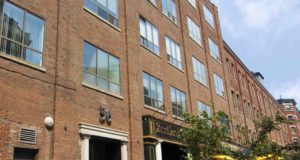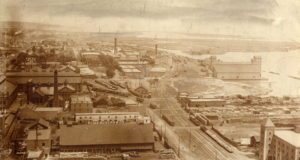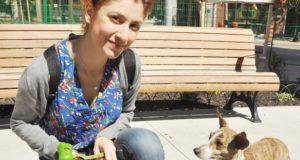Frank Touby —
In 2014 I was asked to deliver a talk to the St. Lawrence Neighbourhood Supper Club which is held regularly at the HotHouse Café. Joining me at the podium were HotHouse owner and community booster Andrew Laffey and St. Lawrence Neighbourhood (SLNA) President Dwight Peters.
Andrew spoke of the history of restaurants in the neighbourhood, is quite entertaining, and has an encyclopedic knowledge of that important part of our area that is so food-based when you consider it’s named for the world-famous St. Lawrence Market. Dwight is a storehouse of facts and positions regarding the neighbourhood and seems to be up-to-date on everything that’s going on and coming up in the neighbourhood.
Here’s the text of my talk:
Hello everyone.
I’m here to talk about our St. Lawrence Neighbourhood.
So I’ll say a bit about how I first experienced the Neighbourhood.
I moved to Toronto in 1971 after spending a winter in Yarmouth, Maine. That was to see how to take a Canadian winter. Prior to that I had never seen snow, since I grew up in Miami. In the Army, which was mandatory in those days, my postings were all in the South Pacific.
My last job in the U.S. was at the Palm Beach Post as editor of the editorial page. One of the writers for the Post, Dave Sims, had gone to Syracuse University and he told me what a fabulous city Toronto is.
So, when it came time for summer vacation, my wife of the time, Susan, and I, came to Toronto and were absolutely blown away. What a fabulous place.
The restaurants here! Not a one of them sold hog jawl and hominy grits. A lot in of restaurants in Florida did in those days. That was before the Cuban invasion of Miami, which I’ve got to admit was a mighty improvement in the local cuisine. Cubans know how to cook.
And so, to my great surprise did Toronto with a cornucopia of really great and varied restaurants. Sure, in South Florida you could find some superb restaurants in the swank hotels, but on the street it was very often fast-food franchises or southern cookin’.
There were hardly any high-quality, medium-priced restaurants like HotHouse.
My first restaurant experience was at Julie’s Mansion on Jarvis Street with the Bombay Bicycle Club bar on top. Later it became a Keg.
Julie’s was a really fine restaurant. From watching movies I had learned that Brits often indulged in what was called “minerals.” That seemed really exotic and I wanted to try them. So I asked my British-accented waiter if they served minerals. “Certainly, sir,” he replied. “What flavor minerals do you want?” So I was a bit deflated to learn that “minerals” was another word for soda pop. My bubble burst.
But it was then that I resolved to move to this wonderful city and got a job as a feature writer on the Toronto Telegram. I was to start on Nov. 1, 1971. But on October 31st, the tely’s owner John Bassett sold it to The Toronto Star, its competitor, which shut it down.
They did find me a job as an editor on the Oakville Daily Journal Record which The Star also owned. But Oakville isn’t Toronto and I always longed to get into the city.
Eventually I did and worked as a reporter on Channel 9, then a copy editor at the Sun and finally for 10 years at the Financial Post as a syndicated radio commentator on things financial and economic.
At the Sun I met and eventually married Paulette Huebert who was introduced to me by Rita Demontis, the Sun’s excellent and revered food editor. Paulette had a small store on the west side of Sherbourne just below King called Literally Dance and Opera.
I moved into the neighbourhood and into Crombie Park Apartments which was owned by Cityhome. That was a remarkably well-run City of Toronto organization that became another tragic victim of the Mike Harris government’s forced amalgamation of our city.
In those days there was a 10-storey limit on the height of buildings in St. Lawrence Neighbourhood. That of course is now gone and the heights of buildings are limited only by the intrusive Ontario Municipal Board which overrules city planners and seems to favour the profit concerns of developers.
On the other hand, all these new buildings are bringing more neighbours into our St. Lawrence Neighbourhood and that should mean even more advocates to help us retain our enviable standard of living here in the big city.
Things have certainly changed over the years, but there are some very strong local organizations that help our causes.
The St. Lawrence Neighbourhood Association is one of the best in Ontario and has a long history of successfully advocating for our residents. Before starting The Bulletin, I was active on the executive of SLNA when P.J. Nicholson was president. He was a strong advocate for the neighbourhood and was the spearhead for our finally getting the St. Lawrence Neighbourhood Community Recreation Centre.
That was a long struggle with city hall and PJ was a bulldog pressuring council and the bureaucracy.
Among the features he fought for was avoiding an Olympic-sized swimming pool. PJ felt that it could be taken away from local people at various times to serve as a training pool for Olympics or even as a competition venue for things like the PanAm games. He wanted it for the neighbourhood only.
By the way, if you haven’t visited Corktown Common, you are in for a huge and wonderful surprise. It’s the legacy of the PanAm Games even before the games begin. It has to be one of the most beautifully designed and usable public spaces on the planet. Go there. I can’t begin to describe how wonderful it is.
I followed PJ as president of SLNA after he retired and then I gave up the office when Paulette and I started The Bulletin, which was initially called the St. Lawrence Neighbourhood Community Bulletin … 17 years ago.
Another strong community organization is the St. Lawrence Market Neighbourhood Business Improvement Area. The BIA. That is the group dedicated to maintaining and improving our neighbourhood’s enviable commercial facilities and features. It’s responsible for the beautification of our commercial streets and sidewalks and is an advocate for local businesses.
In large part, the BIA has created the look and feel of our main retail areas. The Bulletin backed the BIA’s move several years ago to expand its coverage of businesses to the east and we spoke to a number of retailers advocating that they vote to join the BIA and we also promoted that move in the newspaper.
The health of neighbourhood’s retail environment is very dependent on how well a BIA maintains its streets and on the vigilance of neighbourhood associations like SLNA.
Speaking of BIAs, the past president of the Toronto Association of BIAs (TABIA) was a tireless community activist. Mike Comstock, now deceased, never took a penny for his many contributions to St. Lawrence Neighbourhood. He invented and oversaw the construction of the Kitchen at St. Lawrence Market. That’s a showcase for Market merchants to interact with their public and show the possibilities for the various foods sold in the Market.
Mike was also a treasured columnist in The Bulletin and we miss him so much. But his passing inspired another ad hoc group that has advocated to rename the gazebo in St. James Park after Michael Comstock.
A group with the unmusical acronym SEDNA serves as a congress for community organizations of all sorts to meet and exchange ideas on a regular basis. The name stands for South East Downtown Network Alliance and it provides a forum where none others exist for many organizations.
The Treasurer of SEDNA, Alan Seymour, is a longtime neighbourhood resident and an active civic volunteer. Like Mike Comstock was, Alan is also stricken with cancer and may not be with us much longer.
It isn’t just official organizations that generate improvements. An ad hoc group of local folks spearheaded the re-design of Berczy Park with a spectacular fountain and all sorts of features for the public, including for kids and dogs. It is going to be a magnificent western gateway to our St. Lawrence Neighbourhood.
When a misguided police officer drove his cruiser into the beloved outdoor basketball court in Crombie Park and utterly demolished the expensive flooring, an ad hoc group formed and negotiated a wonderful replacement and a renewal of the entire court area.
Our future as a neighbourhood is very different from our past. Once a heavy industrial area, it has blossomed into a world-renowned example of how people of all economic stripes can live, work and play harmoniously in a densely populated big city neighbourhood.
And a neighbourhood is what St. Lawrence is. In every sense we are neighbours.
When I first saw St. Lawrence it was under construction. I was living in a house near the Beach. In my view back then, St. Lawrence Neighbourhood was an instant slum being built.
I’m so glad I was so wrong.
 TheBulletin.ca Journal of Downtown Toronto
TheBulletin.ca Journal of Downtown Toronto


